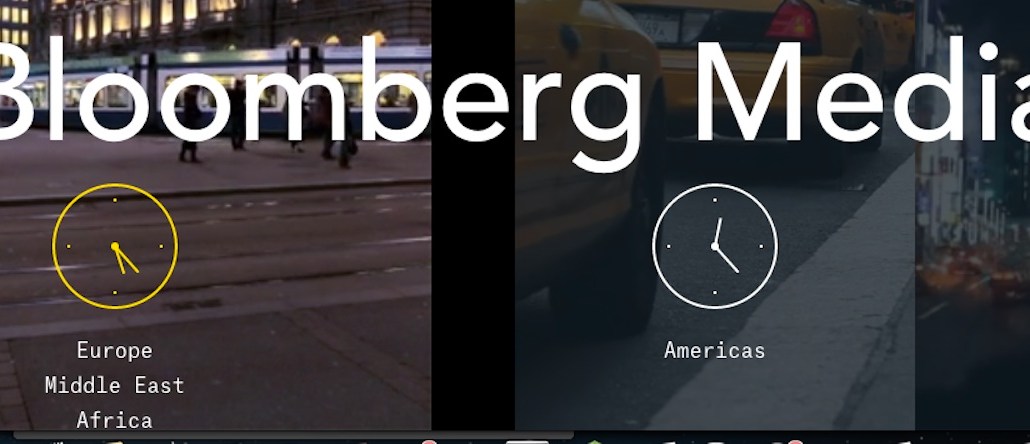Two months in: Bloomberg’s content marketing arm aims ‘to make talking heads sexy’

Kinection, Bloomberg Media’s content division, only became official in May, even though last year the media company produced a dozen multimedia branded content campaigns, shaped by data from Bloomberg Intelligence.
“Everyone has come to realize that bringing video, print and online together in the digital space with dynamic content-management systems will breathe a lot of new life into branded content,” said Arif Durrani, commercial editor for Bloomberg Media Studios in Europe. “In the business space, one of the biggest challenges is how to make a talking head sexy. Brands have woken up to the fact that things need a little more context.”
Revenue from custom content doubled last year, according to the company, which declined to give exact figures but said instead that it’s a multimillion part of Bloomberg’s business.
This month, BMW Group launched #Beyond100, combining a mix of interviews with data and trends on the future of travel. Three months in the making, the BMW Group campaign tackles 100 questions on topics like the switch from petrol to electric, driverless cars and 3-D printing, using a mix of new interviews and repurposed content from the autobrand. It will run across Bloomberg Businessweek, Bloomberg Pursuits and Bloomberg.com, along with supporting social media activity across Bloomberg and BMW Group.
Bloomberg Kinection’s unique appeal, apart from its audience of business professionals, is the access to Bloomberg Intelligence, the 300-person network of data scientists and trend analysis. For BMW Group, it featured graphs on the rise of electric cars. In the next few months, it will add interviews with leaders from MINI and Rolls-Royce, as well as energy experts, and some more data projections from Bloomberg Intelligence, including the impact on oil prices that the rise in electric cars with have.

In May, UBS sponsored a six-part series, each at 30 minutes long, “Forward Thinking,” covering key global challenges that face the next generation, like artificial intelligence, gender inequality and sustainability. Content from this series then informed sponsored-content articles from UBS, like this on why there has only been one female Economics Nobel Prize winner.
Scott Holmes, executive creative director of branded content at DigitasLBi, was positive about Bloomberg’s potential offering to advertisers. “Bloomberg knows what’s going on. Being a news organization puts it in a good position.” However, he thinks the company needs to do more to show the benefits of incorporating Bloomberg Intelligence and data-led creative.
“The principle behind it, understanding what audiences are seeking and marrying brands with that, is great.” Holmes then added, “But whether that actually translates into something different from what the industry has produced before is another question.”
To be sure, the content-marketing space is competitive, and more traditional publishers are getting comfortable with audio visual content marketing. In the business space, the Financial Times, with its heritage in high-quality written journalism, announced a majority stake in Alpha Grid in June, the London video production house, to incorporate into content marketing studio FT2.
Kinection is a global team but has regional offices. In London, the 10-strong team regularly draws on its in-house producers and creative directors, plus a network of 10 freelance journalists. Bloomberg’s own journalists keep away from working on the commercial content. Kinection content doesn’t feature bylines to help emphasize that divide.
Holmes questioned whether there is a market for this in-depth, long-form content from a consumer point of view: “These are important time-poor people, most of them quite content-averse and opinionated. They don’t have time to kill; they want to be informed.”
Even so, advertisers will buy in if Bloomberg is able to put more science into creating and measuring branded content. “Rather than look for reach [because the pool of influential business people is limited] we’re looking for proof they have engaged; it’s been hard for custom content to get credibility because of this.” While others, like The Atlantic, will compare dwell times on branded content to editorial, Bloomberg is finding the right measurements, looking at dwell time, bounce rate, click-through, and soon neuromarketing analytics.
“If you get the content right, then it absolutely is comparable to engagement on editorial,” said Durrani. “I’ve never known us to not hit targets.”
More in Media

What publishers are wishing for this holiday season: End AI scraping and determine AI-powered audience value
Publishers want a fair, structured, regulated AI environment and they also want to define what the next decade of audience metrics looks like.

Media giant Essence launches a marketplace for Black women-led brands
Essence has launched WeLoveUs.shop, a new online marketplace dedicated to Black women-led brands.

In Graphic Detail: The state of AI referral traffic in 2025
The stats reveal a new audience pipeline forming outside of traditional search and social platforms.





